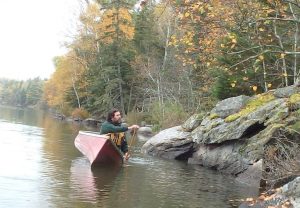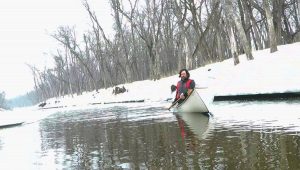My story, by Charles Burchill
 I want to tell you my canoeing story. Some of it is real, and some is pure fantasy; I will let you decide which is which. I want to give you an idea of what Style Canoeing means in my life and where I learned to dance.
I want to tell you my canoeing story. Some of it is real, and some is pure fantasy; I will let you decide which is which. I want to give you an idea of what Style Canoeing means in my life and where I learned to dance.
I grew up in northern lake country with my parents, two older brothers, and a younger sister. The canoe was our utilitarian vehicle – it was used to move things from one place to another, fish, hunt and travel. It was not a toy, it was the pickup truck in our lives.
It was made of wood, built and maintained with our own hands. It was large enough to fit our whole family, some food staples (rice, flour, maybe a deer), our living and shelter needs. It would allow us to go travelling for a month, but small enough to carry one of us across the lake to visit friends for an evening. Paddles were shaped from local trees with a hand axe and drawknife – the blade had to fit within the tree, requiring a long narrow form.
Living on the water I learned the motion of the canoe from infancy to adulthood. The canoe was a stable platform for many activities of life, it was efficient, quiet, a workhorse; it got the task done. When loaded, it travelled straight with little encouragement, and was completely predictable in any condition. When I grew old enough, I took my place ferrying my parents, family and friends, stuff, across the lake and down the river. Learning was a process of watching others, asking a few careful questions, trial and error – figuring out what worked and what allowed me to paddle for hours and days without getting tired or sore.
There were times that the canoe was just not large enough to carry everything. I would cross the lake with my family and my dad would send me back for a load of equipment, lumber, or other staples. My dad and older brothers had work to do, my young sister needed to stay with my mom. At first, crossing the lake was a task to complete – straight there and back no goofing around. Unloaded, the canoe was like a dry fall leaf that had landed on the water – it skittered randomly across the surface, bobbed like a cork on the waves, and was just unpleasant.
I noticed when my dad was out fishing, spending a quiet evening away from us in self contemplation, he would sit near the middle of the canoe. Trying this out I discovered I had much better control, it felt as if I tamed the beast. Crossing the lake became easier and faster. I discovered by keeling close to the edge I could use the same paddle stroke with the same power as when paddling a loaded canoe. Being near the edge caused the canoe to precariously tip at first, but at some point the canoe seemed to get more stable, and I had even more control.

I reveled in these trips, alone, in the quiet, away from my fathers’ scrutinizing eyes, my brothers’ taunting, and my sister (following me around). My brothers had no interest in paddling the canoe, there were more manly things to do, I guess. I volunteered as often as I could to run errands, pickup packages, and take messages across the lake.
I found that the canoe became much more agile when tilted up on edge, and because I was quick, I could spend a little time exploring on my solo voyages. When I got older, I took the canoe for longer outings fishing, checking traps, or, in reality, getting some quiet time. The canoe could be encouraged to spin, and turn, and glide in more ways than I thought possible. The random motion of a skittering leaf became a dance across the lake. Purposeful, but delicate, the motion over the water was intoxicating.


I eventually left the lake and river on my own life’s journey. I never forgot the lessons I learned and the feeling of canoe, paddle, and water. Recently I returned to the lake; I arrived early in the morning when the mist was still drifting across the lake, the surface still as glass. I knew my dad continued to make the crossing every morning checking for messages and to pick up any packages.
Through the morning mist a canoe came gliding silently into view. It moved gracefully across the water, barely causing a ripple, traveling in loops and spins, maybe a hint of a pause (an exclamation), then continuing in the opposite direction – it was a beautiful dance. When he approached the shore, my stern quiet dad winked, I knew then that we shared the same secret knowledge.

I dance in memory of my dad.
Charles Burchill, 2019